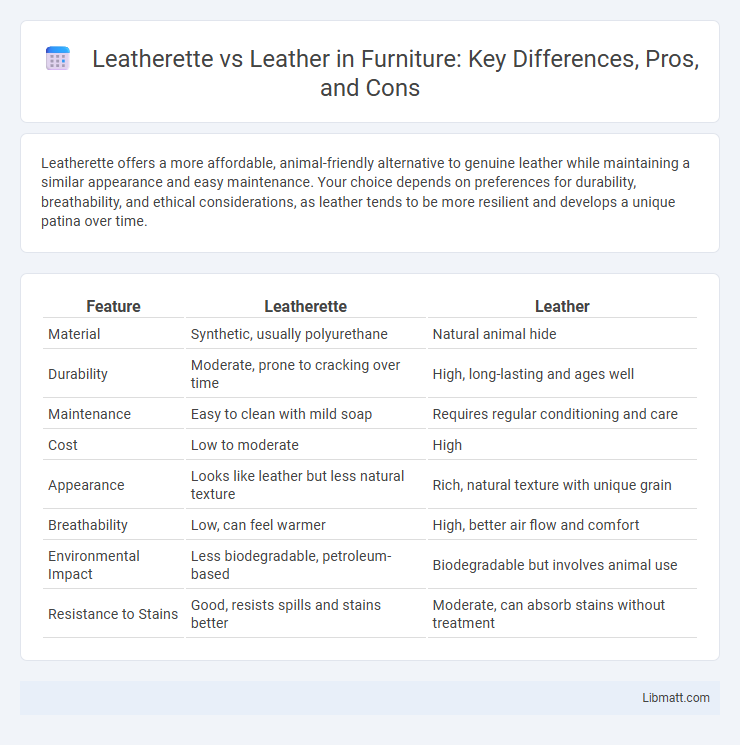Leatherette offers a more affordable, animal-friendly alternative to genuine leather while maintaining a similar appearance and easy maintenance. Your choice depends on preferences for durability, breathability, and ethical considerations, as leather tends to be more resilient and develops a unique patina over time.
Table of Comparison
| Feature | Leatherette | Leather |
|---|---|---|
| Material | Synthetic, usually polyurethane | Natural animal hide |
| Durability | Moderate, prone to cracking over time | High, long-lasting and ages well |
| Maintenance | Easy to clean with mild soap | Requires regular conditioning and care |
| Cost | Low to moderate | High |
| Appearance | Looks like leather but less natural texture | Rich, natural texture with unique grain |
| Breathability | Low, can feel warmer | High, better air flow and comfort |
| Environmental Impact | Less biodegradable, petroleum-based | Biodegradable but involves animal use |
| Resistance to Stains | Good, resists spills and stains better | Moderate, can absorb stains without treatment |
Introduction to Leatherette and Leather
Leatherette is a synthetic material designed to mimic the look and feel of natural leather, offering a more affordable and cruelty-free alternative. Genuine leather is derived from animal hides and is prized for its durability, breathability, and unique aging characteristics. Both materials are widely used in fashion, upholstery, and automotive industries, each offering distinct benefits depending on consumer preferences and environmental considerations.
Defining Leatherette: What Is It?
Leatherette is a synthetic material designed to mimic the appearance and texture of genuine leather, made primarily from polyurethane or polyvinyl chloride (PVC). It offers a cost-effective, durable, and animal-friendly alternative to real leather, resistant to stains and easier to maintain. Your choice between leatherette and leather depends on preferences for authenticity, sustainability, and budget considerations.
Understanding Real Leather
Real leather is derived from animal hides, offering a unique texture, durability, and breathability that leatherette lacks due to its synthetic composition. Natural leather develops a patina over time, enhancing its appearance and longevity, whereas leatherette tends to crack and peel with wear. The intrinsic fibers and pores in real leather provide superior comfort and moisture regulation compared to the artificial materials used in leatherette.
Key Differences: Leatherette vs Leather
Leatherette, a synthetic material made from plastic, mimics the appearance of genuine leather but lacks its natural texture and durability. Genuine leather, derived from animal hides, offers superior breathability, flexibility, and aging characteristics, developing a unique patina over time. Leatherette is more affordable, water-resistant, and easier to maintain, while leather provides higher resilience and a more luxurious, authentic feel.
Durability and Longevity Comparison
Leather offers superior durability and longevity compared to leatherette, as it withstands wear and tear better due to its natural fibers and robust structure. Leatherette, while more affordable and resistant to water and stains, tends to crack and peel over time, reducing its lifespan significantly. Your choice between the two should consider how long-lasting and resilient you need the material to be for everyday use.
Comfort and Feel: What to Expect
Leatherette offers a smooth and consistent texture that remains cool to the touch, making it easy to maintain but less breathable than genuine leather. Genuine leather provides a softer, more supple feel that molds to your body over time, enhancing comfort through natural breathability and temperature regulation. Your choice will depend on whether you prioritize easy upkeep with a firm feel or the luxurious, adaptive softness that real leather delivers.
Cost Analysis: Leatherette vs Leather
Leatherette offers a significantly lower upfront cost compared to genuine leather, making it a budget-friendly choice for furniture, car interiors, and fashion accessories. While leather provides durability and ages with character, its higher purchase price and maintenance expenses can impact long-term affordability. Your decision should weigh initial investment against longevity and care requirements for the best value.
Maintenance and Care Tips
Leatherette requires minimal maintenance compared to genuine leather, as it is more resistant to stains and water, making regular wiping with a damp cloth sufficient. Genuine leather demands routine conditioning with specialized leather creams to prevent drying and cracking, especially in environments with fluctuating humidity. Proper care extends the lifespan of both materials, but leather's natural fibers necessitate more attentive upkeep to maintain its texture and appearance.
Environmental Impact and Sustainability
Leatherette has a lower environmental impact compared to traditional leather, as it avoids animal farming and reduces greenhouse gas emissions linked to livestock. However, leatherette, often made from synthetic materials like PVC or polyurethane, can contribute to microplastic pollution and relies on fossil fuels, raising concerns about its sustainability. Your choice between leather and leatherette should consider both the carbon footprint and the product's biodegradability to align with eco-friendly goals.
Which One Should You Choose?
Leatherette offers a budget-friendly and cruelty-free alternative to genuine leather, making it ideal for those seeking stylish, easy-to-maintain materials without sacrificing appearance. Genuine leather provides superior durability, breathability, and develops a unique patina over time, appealing to those prioritizing longevity and natural texture. Your choice depends on balancing cost, ethical preferences, and desired lifespan, with leatherette suiting short-term use and leather benefiting long-term investment.
leatherette vs leather Infographic

 libmatt.com
libmatt.com